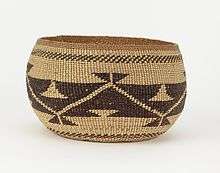Rowena Bradley

Rowena Bradley (1922–2003) was a Cherokee basketweaver.
Rowena Bradley was born in 1922 to Nancy George Bradley (1881–1963) and Henry Bradley, the youngest of eight children.[1] She grew up on the Painttown Community's Swimmer Branch on the Qualla Boundary.[2] She learned weaving by observing her mother, who alongside her grandmother Mary Dobson (Tahtahyeh, b. ca. 1857) was accomplished at basket making.[3] While neither her mother nor her grandmother spoke English, their wares made their way as far as Washington and New York.[4] Rowena created her first basket at the age of six.[2]
Bradley was a student of basketweaver Lottie Queen Stamper, who taught basketmaking at the Cherokee boarding school.[5]
Bradley crafted baskets from rivercane and was one of few weavers with knowledge of a double-weave technique. She quartered, peeled, and scraped the rivercane with a pocketknife. The dye materials she used were derived from local bark and roots such as butternut, black walnut and bloodroot.[2] She wove patterns that she learned from her mother and made her own designs.[6] Her favored designs are now known as Peace Pipe, Double Peace Pipe, and Chief's Daughter.[5]
Journalist John Parris described the process Bradley used in weaving, "working from memory, she forms the strips into patterns and then into baskets of all shapes and sizes. Early in the process of a double-weave pattern, literally scores of withes seem to fly out in all directions."[7] Bradley devised new types of baskets, including a Purse Basket for sales to tourists.[5]
Bradley's basketry was featured in a 1974 exhibition at Qualla Arts and Crafts Mutual in Cherokee. The exhibition was partially funded by the North Carolina Arts Council and the Indian Arts and Crafts Board.[2] She was recognized as "one of the foremost masters of rivercane basketry and one the most talented, creative basketmakers in the United States."[5] Stephen Richmond wrote that Bradley's work was a "new dimension of technical and aesthetic achievement."[8]
References
- Notes
- ↑ Fariello 2009, p. 106.
- 1 2 3 4 Fariello, Anna (2009). Cherokee Basketry: From the Hands of our Elders. The History Press.
- ↑ Hill, Sarah H. (1997). Weaving New Worlds: Southeastern Cherokee Women and their Basketry. Chapel Hill: University of North Carolina Press. pp. xv–xvii. ISBN 978-0-8078-2345-3.
- ↑ Neely, Sharlotte (January 1998). "Tradition and Change in the World of Cherokee Women". The Georgia Historical Quarterly. 82 (4): 849. JSTOR 40583908.
- 1 2 3 4 Power, Susan C. (2007). Art of the Cherokee: Prehistory to the Present. Athens, Georgia: University of Georgia Press. pp. 137, 202. ISBN 978-0-8203-2766-2.
- ↑ Fariello 2009, p. 97.
- ↑ Fariello 2009, p. 80.
- ↑ Fariello 2009, p. 82.
- Bibliography
- Fariello, M. Anna (2009). Cherokee Basketry: From the Hands of Our Elders (1st ed.). Charleston, South Carolina: The History Press. ISBN 978-1-59629-721-0.